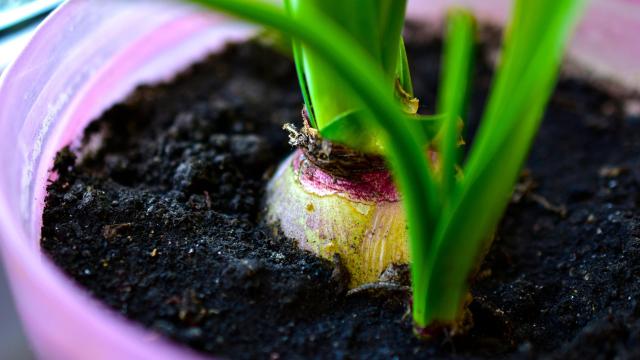Seeing some green poking through the snow or cold, winter ground is one of the most visible signs of spring. But seeing how we’re not even a month into winter, it’ll take some time before that happens. Unless, of course, you’ve been growing bulbs inside.
The official term for that is “forcing” bulbs, and though that sounds a little coercive, it’s more deceptive than aggressive. That’s because forcing bulbs is essentially tricking them into thinking that spring is here. Here’s what to know about forcing bulbs.
How to force bulbs indoors
Essentially, the process is pretty similar to the one outdoors, except that you’re planting the bulbs in pots, and simulating the old, dark winter conditions they need to grow. There is plenty of gardening advice out there with additional details, but here are the basics:
- Start by planting the bulbs in a shallow pot or bowl, using loamy compost with some added grit to allow for drainage.
- Be sure to place the bulb with its pointy tip facing up — slightly below the surface of the soil — then fill in the soil around it.
- Once the bulbs are potted, put the pots in storage in a cool, dark place. One option is to line a box or drawer with a heavy-duty black garbage bag, place the pots in there, and then store in a garage, basement, cellar, or shed (depending on your local climate). The key is to make sure it’s somewhere where the temperature doesn’t get above 50 degrees Fahrenheit.
- Do a welfare check on your bulbs every few weeks, and water them lightly if they seem to be dry.
What is the timeline for forcing bulbs?
In most cases, bulbs need 12 to 15 weeks of pretend winter in cold storage in order to become sufficiently rooted and are in a position to bloom. Some flowers need more cold treatment than others. Here are a few examples of the length of time different kinds of bulbs should spend in cold treatment:
- Crocus, iris reticulata, and snowdrops: 15 weeks of cold
- Daffodils: 15 to 17 weeks
- Hyacinths: 11 to 14 weeks
- Muscari: 13 to 15 weeks
- Scilla: 12 to 15 weeks
- Tulips: 14 to 20 weeks
You’ll know that the bulbs are ready to come out from the cold when you can see roots at the bottom of the pot. Even if you see the plant start to sprout on top, if it doesn’t have visible roots, it’s not ready yet.
When the roots are there, give the plants some time to get used to the warmer climate, by placing them somewhere in your home that is cool and bright (and away from a heat source) for two or three weeks. In most cases, the bulbs will begin to bloom in two to five weeks.

Leave a Reply
You must be logged in to post a comment.